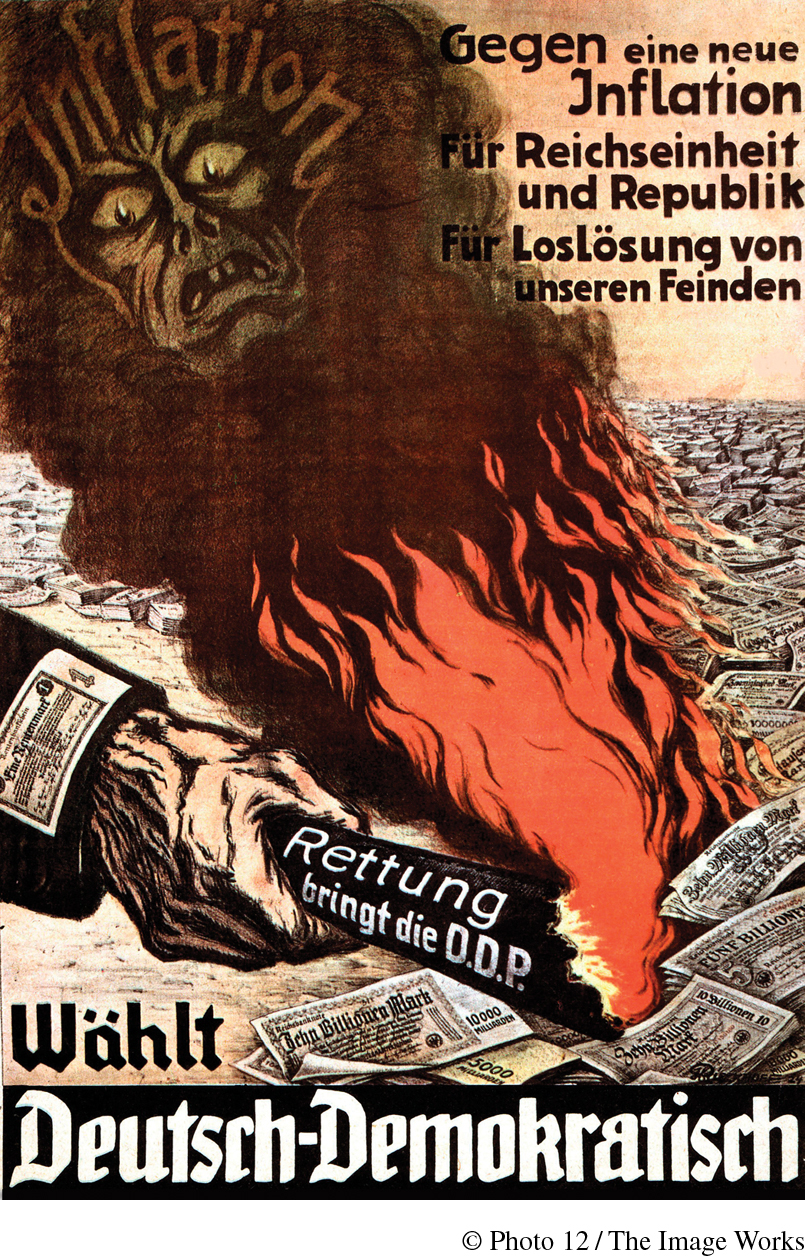Economic and Diplomatic Consequences of the Peace
Printed Page 838
Important EventsEconomic and Diplomatic Consequences of the Peace
The Peace of Paris extended at least two problems into the 1920s and beyond. The first was economic recovery and its relationship to war debts and German reparation payments. The second was ensuring that peace actually came about and lasted. France, hardest hit by wartime destruction and billions of dollars in debt to the United States, estimated that Germany owed it at least $200 billion. Britain, by contrast, had not been physically devastated and was worried instead about maintaining its empire and restoring trade with Germany, not exacting huge reparations to rebuild. Nevertheless, both France and Britain were dependent on some German payments to settle their war debts to the United States.

Germany claimed that the demand for reparations strained its government, already facing political upheaval. In fact, Germany’s economic problems had begun long before the Peace of Paris. They had started with the kaiser’s policy of not raising taxes—especially on the rich—to pay for the war, leaving the new republic with a staggering debt. Now this republic, an experiment in democracy, needed to win over its citizens, and hiking taxes to pay Germany’s debt would only anger them. In 1921, when Germans refused to present a realistic plan for paying reparations, the French occupied several cities in the Ruhr basin until a settlement was reached.
Germany’s relations with powers to the west continued to deteriorate. In 1923, after Germany defaulted on coal deliveries, the French (this time joined by the Belgians) again sent troops into the Ruhr basin, planning to seize its output to pay the wartime debt. Urged on by the government, Ruhr citizens shut down industry by staying home from work. The German government printed trillions of marks to support the workers and to pay its own war debts with practically worthless currency. The result was a staggering inflation in Germany: at one point, a single U.S. dollar cost 4.42 trillion marks, and wheelbarrows of money were required to buy a turnip. Negotiations to resolve this economic chaos resulted in the Dawes Plan (1924) and the Young Plan (1929), which reduced reparations and restored the value of German currency. Before that happened, however, inflation had wiped out people’s savings and turned many more Germans against their democratic government.
The second burning issue unresolved by the Peace of Paris involved making the peace take hold and last. Statesmen determined that peace needed disarmament, a return of Germany to the community of nations, and security for the new countries of eastern Europe. Hard diplomatic bargaining produced two plans in Germany’s favor. At the Washington Conference in 1921, the United States, Great Britain, Japan, France, and Italy agreed to reduce their number of battleships and to stop constructing new ones for ten years. Four years later, in 1925, the League of Nations sponsored a meeting of the great powers, including Germany, at Locarno, Switzerland. The Treaty of Locarno provided Germany with a seat in the league as of 1926. In return, Germany agreed not to violate the borders of France and Belgium and to keep the nearby Rhineland demilitarized—that is, unfortified by troops.
To the east, statesmen feared a German attempt to regain territory lost to Poland, to merge with Austria, or to launch any attack on states spun off from Austria-Hungary. To meet this threat, Czechoslovakia, Yugoslavia, and Romania formed the Little Entente in 1920–1921, a collective security agreement intended to protect them from Germany and Russia. Between 1924 and 1927, France allied itself with the Little Entente and with Poland. In 1928, sixty nations, including the major European powers, Japan, and the United States, signed the Kellogg-Briand Pact, which formally rejected international violence. The pact lacked any mechanism for enforcement and thus resembled, as one critic put it, “an international kiss.”
REVIEW QUESTION What were the major outcomes of the postwar peacemaking process?
The publicity surrounding the international agreements of the 1920s sharply contrasted with old-style diplomacy, which had been conducted in secret and subject to little public scrutiny. The development of a system of open, collective security suggested a diplomatic revolution that would promote international peace. Yet openness allowed diplomats to feed the press information designed to provoke the masses. For example, the press and opposition parties whipped the German populace into a nationalist fury whenever Germany’s diplomats appeared to compromise, even though these compromises worked to undo the Treaty of Versailles. Journalists who hated republican government used international meetings such as the one at Locarno to fire up political hatreds rather than promote peace or rational public discussion.